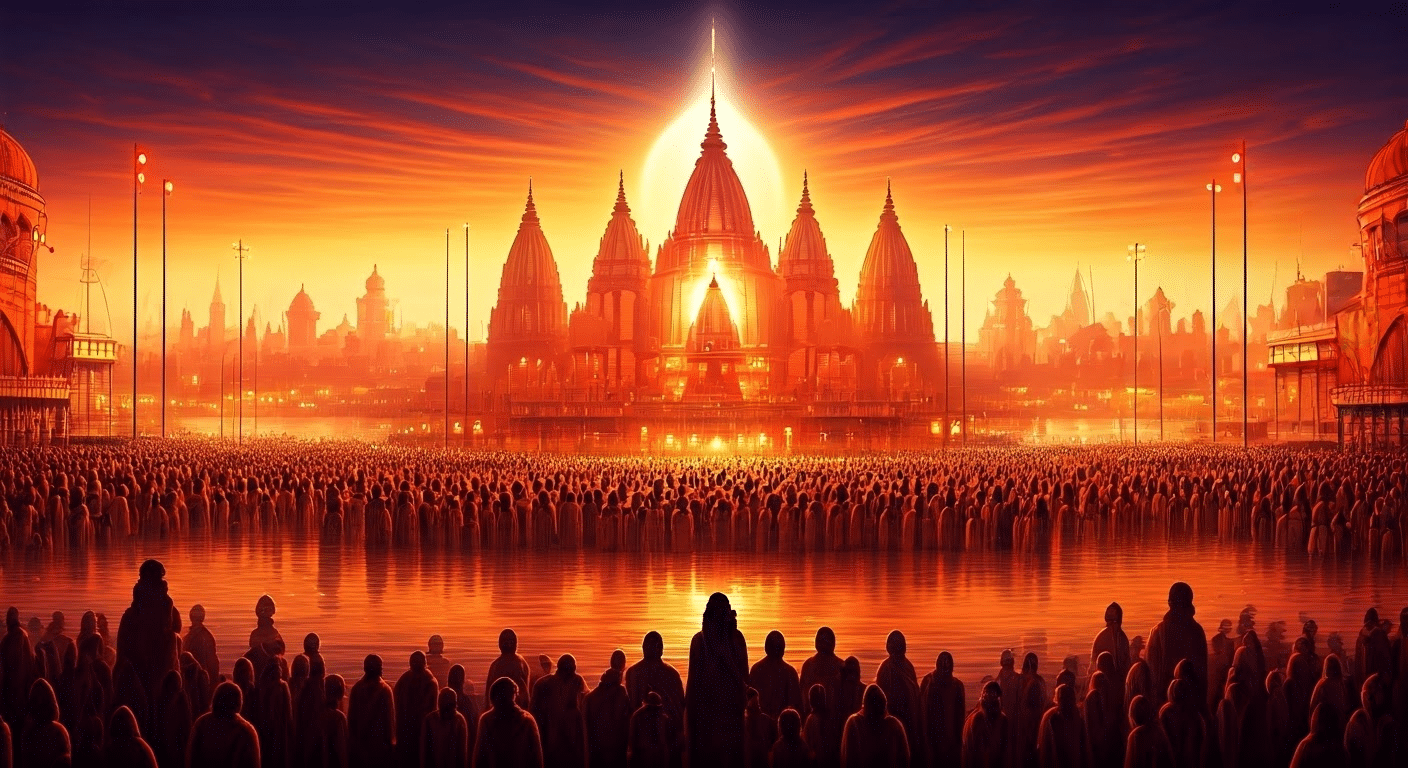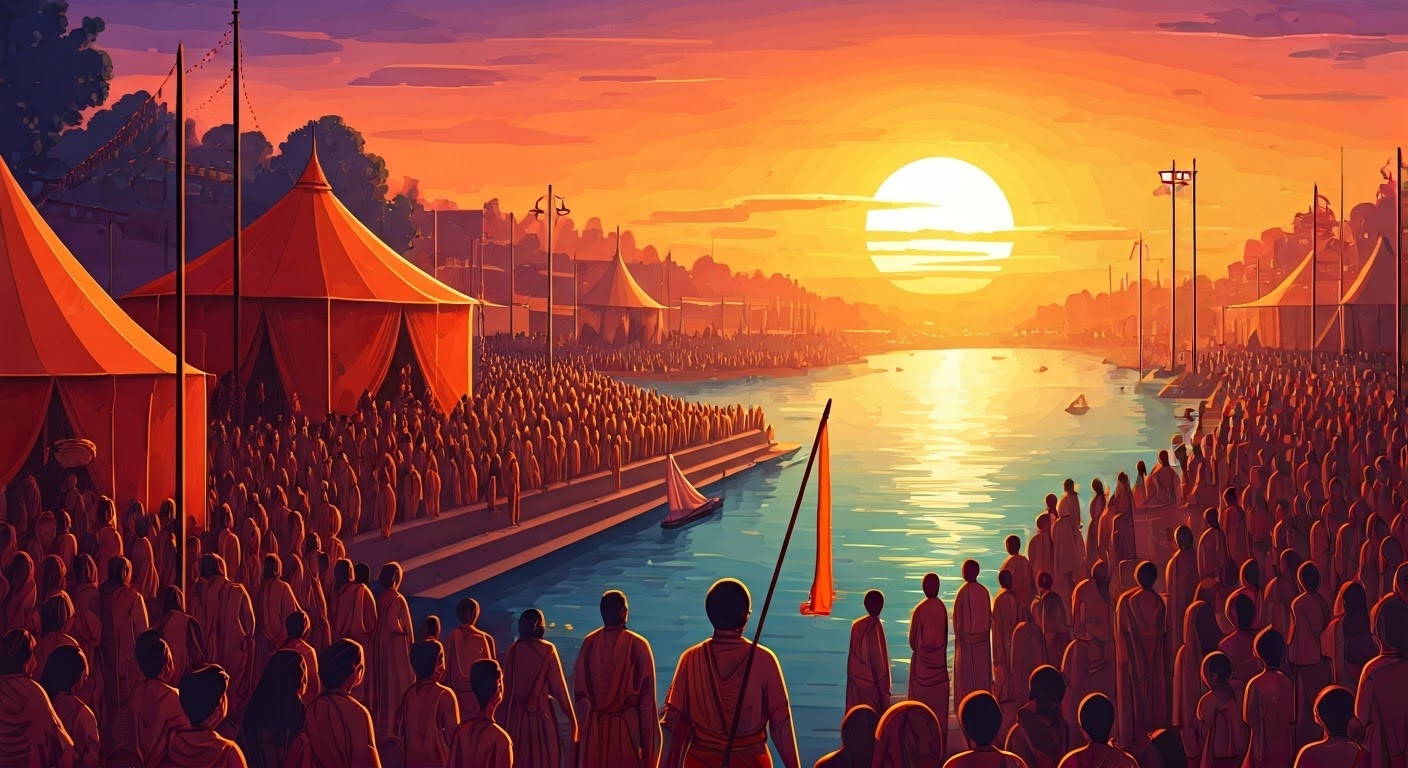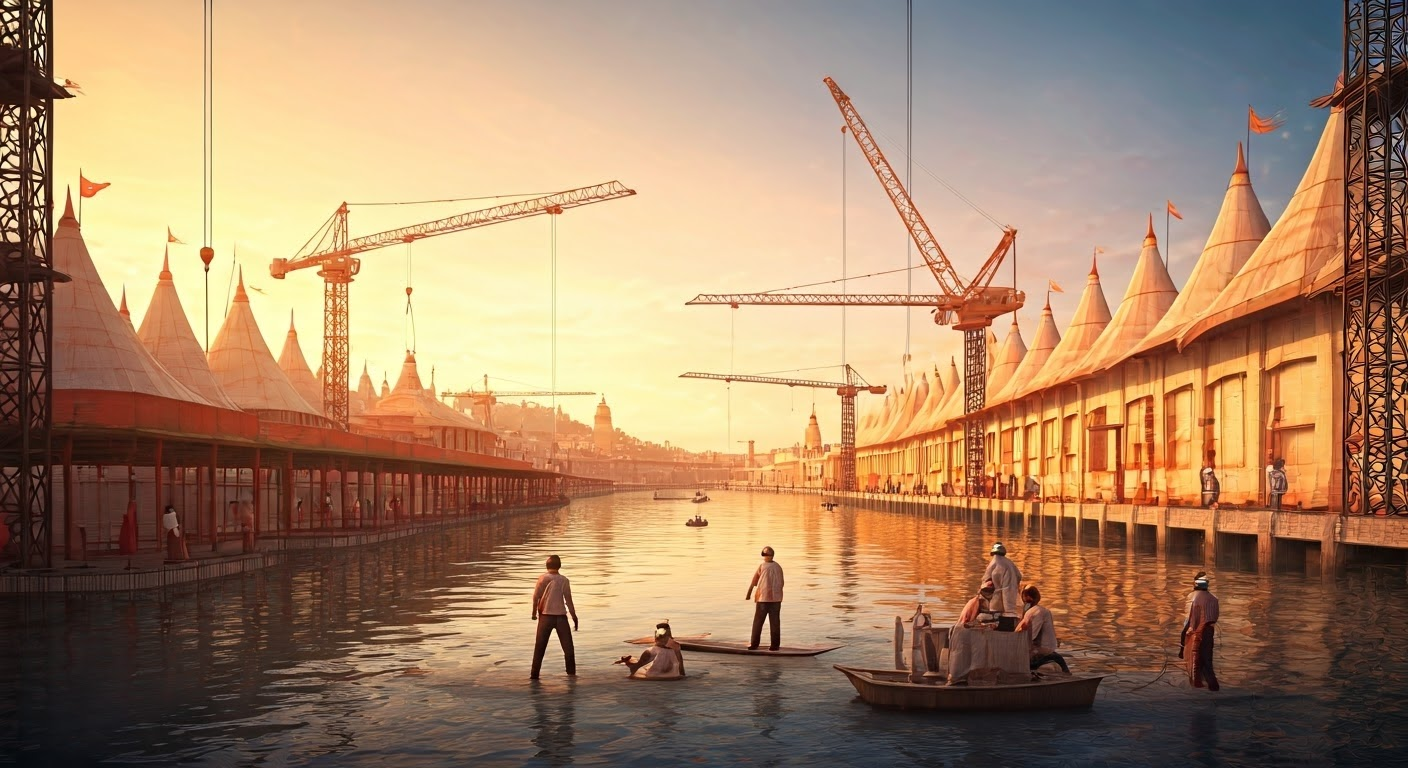
Key Highlights
- The Maha Kumbh 2025, hosted in Prayagraj, is projected to host a staggering 45 crore visitors.
- This mega-event signifies a massive economic opportunity, with a projected revenue generation of ₹2 lakh crore for Uttar Pradesh.
- The state government is heavily investing ₹7,500 crore toward infrastructure development, including enhanced sanitation, upgraded public utilities, and improved road connectivity.
- A sprawling 4,000-hectare tent city will house pilgrims, reflecting the event’s colossal scale.
- Security is paramount, with 40,000 police personnel deployed alongside AI-powered surveillance systems.
Introduction
The Maha Kumbh, often dubbed the “festival of the sacred pitcher,” is more than just a religious pilgrimage; it’s a profound spectacle of faith, drawing millions to the sacred confluence of the Ganga, Yamuna, and the mythical Saraswati in Prayagraj, India. This colossal gathering, rooted in Hindu mythology, represents a harmonious blend of ancient rituals, spiritual cleansing, and a vibrant display of cultural heritage.
Impact of MahaKumbh: The Numbers Behind Mahakumbh

The Maha Kumbh 2025 is not just a spiritual event; it’s an economic powerhouse. With a projected 45 crore attendees, including domestic and international tourists, the Confederation of All India Traders (CAIT) estimates a potential ₹2 lakh crore revenue surge for Uttar Pradesh. This projection assumes an average expenditure of ₹5,000 per visitor on accommodations, food, religious artifacts, and local transport.
Beyond direct revenue, the Maha Kumbh fosters immense economic activity by generating an estimated 6-7 lakh temporary jobs. Over 2 lakh artisans and vendors are expected to participate, invigorating the local economy and spotlighting traditional Indian crafts.
The Economic Powerhouse: Mahakumbh 2025’s Budget and Expenditures
Recognizing the scale of the Maha Kumbh, the central and Uttar Pradesh governments have allocated a substantial ₹7,500 crore budget. This investment aims to ensure a seamless experience for the millions of pilgrims by focusing on critical areas such as robust infrastructure development, environmental safeguards, and comprehensive security apparatus.
Overview of the ₹7,500 Crore Budget Allocation
This budgetary commitment underscores the government’s dedication to handling the massive influx of pilgrims expected at the Maha Kumbh 2025. A significant portion of the ₹7,500 crore is earmarked for fortifying Prayagraj’s infrastructure, particularly enhancing connectivity to the mela site.
Furthermore, the Uttar Pradesh government emphasizes the event’s sustainability by allocating funds towards environmental conservation. This includes implementing eco-friendly waste management solutions, preserving the sanctity of the Ganges River, and promoting responsible tourism practices among visitors.
With meticulous planning and execution, this substantial budget aims to ensure a safe, spiritually enriching, and unforgettable Maha Kumbh experience for millions of devotees.
Infrastructure Development: A Closer Look at Financial Commitments
Recognizing infrastructure’s vital role in accommodating the massive influx of pilgrims, the Uttar Pradesh government allocated a significant portion (approximately ₹7,000 crore) of the total budget towards bolstering Prayagraj’s infrastructure.
Here’s a snapshot of the key infrastructural developments and their respective financial commitments:
| Project | Allocation (in ₹ crore) |
| Road and bridge construction/improvement | 2,500 |
| Sanitation and waste management systems | 1,500 |
| Upgraded water supply and electricity | 1,000 |
| Construction of tent city | 2,000 |
These developments are crucial not only for the smooth execution of the Maha Kumbh but also for fostering long-term economic activity in the region.
The Spiritual Epicenter: Rituals and Ceremonies of Mahakumbh
The heart of the Maha Kumbh pulsates with a rhythm set by ancient rituals and ceremonies. Millions converge not just to witness but to participate in these sacred practices, seeking spiritual cleansing and blessings. The city of Prayagraj transforms into a vibrant tapestry of faith, echoing with chants, hymns, and the joyous celebrations of shared spirituality.
The Significance of Bathing Dates and Their Impact
Central to the Maha Kumbh experience is the holy dip in the confluence of the Ganga, Yamuna, and the mythical Saraswati – the Triveni Sangam. However, these dips aren’t arbitrary; they are intricately tied to specific dates determined by the Hindu calendar and hold immense religious significance.
These ‘Shahi Snan’ or royal bathing days are believed to be particularly auspicious, attracting a surge of devotees seeking spiritual purification. The precise timing is meticulously calculated by astrologers, taking into account planetary positions and other celestial factors.
This confluence of faith, tradition, and astrology transforms the mela site into a breathtaking spectacle on these auspicious bathing dates.
Processions and Rituals: The Heart of Mahakumbh
Beyond the holy dips, the Maha Kumbh resonates with a plethora of processions and rituals that captivate the senses and nourish the soul. From the Peshwai procession, where different Akharas showcase their spiritual prowess, to the mesmerizing evening aarti ceremonies along the Ghats of the Sangam, the atmosphere vibrates with energy and devotion.
Adding to the grandeur are the Naga Sadhus, ascetic warriors who have renounced worldly possessions, leading processions with their chants and rituals. Their presence, often under the watchful eyes of dignitaries like Chief Minister Yogi Adityanath, adds a layer of mysticism and reverence to this already spiritually charged event.
₹7,000 Crores for Infrastructure Development

A significant portion of the total budget, a staggering ₹7,000 crores, has been earmarked for the enhancement of Prayagraj’s infrastructure. This investment aims to provide the millions of expected visitors with a comfortable and hassle-free experience.
The funds will be strategically utilized for a multitude of projects, with a keen focus on improving accessibility to the Kumbh Mela site. This includes the construction of new roads and bridges, upgrading existing transportation networks, and ensuring seamless connectivity within the city.
By investing heavily in infrastructure, the government aims to not only cater to the immediate needs of the event but also to create a lasting legacy of development for Prayagraj.
₹500 Crores for Environmental Conservation
Demonstrating a strong commitment towards environmental sustainability, the Uttar Pradesh government has dedicated ₹500 crores for conservation efforts throughout the Maha Kumbh. This commitment reflects an understanding that such a large-scale event necessitates responsible environmental practices.
A large portion of this allocation will be directed towards cleaning and maintaining the Ganga River. This includes initiatives to prevent pollution from entering the river, ensuring the safety of the holy waters for the millions who will partake in the ritual bathing.
Beyond the Ganges, the government plans to implement comprehensive waste management systems throughout the Mela grounds. By employing eco-friendly solutions, the aim is to minimize the environmental impact and leave a legacy of sustainability.
4,000-hectare Tent City for Pilgrims
To accommodate the unprecedented number of pilgrims, a colossal tent city, spanning an area equivalent to 5,600 football fields, has been erected. This temporary metropolis will house pilgrims from across India and beyond, offering basic amenities and a sense of community.
This 4,000-hectare tent city is a testament to the sheer magnitude of the event and the meticulous planning involved. Within this meticulously planned tent city, pilgrims will have access to essential amenities like temporary housing, sanitation facilities, food stalls, and medical camps.
It serves as a microcosm of the Kumbh Mela itself, reflecting the principles of unity, sharing, and devotion that underpin this grand event.
Security and Surveillance Measures
Ensuring the safety and security of millions congregated for the Maha Kumbh is a mammoth task. To tackle this challenge, authorities have implemented a multi-layered security apparatus, deploying a 40,000-strong security force, including specialized units.
Beyond the substantial human resource deployment, cutting-edge technology like AI-powered surveillance systems forms the backbone of the security strategy. This includes utilizing facial recognition software for enhanced vigilance and real-time crowd monitoring to preempt and respond to potential situations efficiently.
The integration of sophisticated technology alongside traditional policing methods highlights the commitment to ensuring a secure and peaceful experience for all attendees.
167 Projects worth ₹5,500 Crores Inaugurated by the Prime Minister
In anticipation of the Maha Kumbh, a slew of 167 infrastructure projects, totaling a massive ₹5,500 crores, have been inaugurated. These projects are a testament to the government’s dedication to transforming Prayagraj, enhancing accessibility for pilgrims, and leaving behind an enduring legacy of development.
These projects encompass a wide array of infrastructural enhancements, ranging from the construction of 14 new flyovers to ease traffic congestion to the development of 7 new bus stations to improve transport links for the millions of travelers. The inclusion of 9 new permanent ghats, alongside 12 kilometers of temporary ghats, speaks to the event’s spiritual significance and the need for efficient crowd management during the key bathing rituals.
The impact of these projects goes beyond the immediate needs of the Maha Kumbh, having the potential to stimulate economic activity and improve the lives of residents for years to come.
Companies and Shares Likely to Benefit from Mahakumbh 2025
The Mahakumbh, with its massive scale and economic activity, creates a ripple effect across various sectors, presenting lucrative opportunities for companies in diverse industries. Major corporations, recognizing this potential, have already invested heavily, securing branding rights and positioning themselves to benefit from the surge in demand.
Hospitality chains, food and beverage companies, consumer goods manufacturers, and companies involved in transportation, telecommunications, and logistics stand to gain significantly. Leading players like Reliance Industries, ITC, Tata Group, and Hindustan Unilever, with their extensive reach and diverse product portfolios, are strategically positioned to cater to the needs of the vast crowds and reap the benefits of the economic boom during the Mahakumbh.
Rituals
The Maha Kumbh is a vibrant tapestry woven with ancient rituals passed down through generations. It’s a spiritual journey where devotees and ascetics converge, their collective faith echoing in unison amidst a sea of humanity. At the heart of the Kumbh are the sacred bathing rituals, but the event transcends mere ceremonial practices; it’s a celebration of faith, a testament to ancient traditions, and a reaffirmation of shared beliefs.
Bathing and processions
The act of bathing in the sacred Sangam, where the Ganges, Yamuna, and the mythical Saraswati rivers are believed to converge, is central to the Kumbh Mela. For millions of Hindus, this ritual symbolizes purification and spiritual rebirth. The Kumbh’s significance is deeply intertwined with Prayagraj (formerly Allahabad), a city where faith and history merge.
The spectacle of millions immersing themselves in the holy waters, many clad in white to symbolize purity, is a sight to behold. These mass bathing events, known as ‘Shahi Snans’ or royal baths, are held on astrologically auspicious days, adding another layer of significance to the act.
Feasts, festivities and discussions
Beyond the rituals and bathing, the Maha Kumbh is a vibrant celebration of life and faith. The mela grounds come alive with a carnival-like atmosphere as pilgrims engage in diverse activities, enriching the experience and bolstering the local economy.
The air is thick with the aroma of traditional delicacies as food stalls offer a taste of local cuisine. Pilgrims indulge in friendly exchanges, sharing stories of their faith and cultural experiences. The Confederation of All India Traders (CAIT) recognizes this opportunity, highlighting the economic boost provided by such large-scale gatherings.
The Maha Kumbh also serves as a platform for spiritual discourses and religious gatherings, fostering a sense of community and shared wisdom. Through storytelling, philosophical debates, and devotional singing, the Kumbh transcends its religious framework, becoming a platform for cultural exchange and spiritual exploration.
Darshan
Calendar, locations and preparation
The Kumbh Mela, in all its variations, unfolds across a 12-year cycle, rotating between four sacred cities in India. The anticipation and preparation begin years in advance, with authorities and communities meticulously planning to accommodate the influx of millions of devotees. The Kumbh’s cyclical nature underscores its integral role in the lives of millions, serving as a spiritual milestone marked on calendars and eagerly awaited.
Types
The Kumbh Mela, an umbrella term for this grand spectacle of faith, encompasses three distinct variations, each with its own significance and scale. The most frequent is the Ardh Kumbh, held every six years in Haridwar and Prayagraj. As the name suggests, Ardh Kumbh is considered to be half the scale of the Purna Kumbh, attracting a slightly smaller yet still impressive number of devotees.
The Purna Kumbh, a grander spectacle occurring every 12 years, rotates between four sacred cities: Haridwar, Prayagraj, Nashik, and Ujjain. The Kumbh Mela held in 2025 is a Purna Kumbh, and its occurrence in Prayagraj elevates its significance, promising a confluence of history, faith, and cultural vibrancy.
The pinnacle of the Kumbh cycle is the Maha Kumbh Mela, celebrated only in Prayagraj once every 144 years, making it an extremely rare and auspicious event. Its occurrence in Prayagraj, a city steeped in religious significance, amplifies its sanctity and draws a truly unparalleled gathering of humanity.
Locations
The Kumbh Mela, a celebration deeply interwoven with geography and faith, rotates between four sacred cities in India, each holding a unique place in Hindu mythology. Prayagraj, formerly known as Allahabad, holds the distinction of hosting the Maha Kumbh, the grandest and most auspicious of all Kumbh gatherings.
Haridwar, nestled in the foothills of the Himalayas, witnesses a confluence of faith and nature during the Kumbh Mela, where the sacred Ganges River descends into the plains. Nashik, situated on the banks of the Godavari River in Maharashtra, draws millions who come to bathe in the holy waters and participate in the vibrant festivities.
Ujjain, an ancient city in Madhya Pradesh known for its association with Lord Shiva, hosts the Kumbh Mela on the banks of the Shipra River, attracting devotees and ascetics drawn to its spiritual aura. The Kumbh’s rotation through these cities underscores its pan-Indian appeal, uniting people from all corners of the country in a shared celebration of faith.
Dates
The dates of the Kumbh Mela are not arbitrarily chosen but rather meticulously determined by a complex astrological calendar, factoring in planetary positions and celestial events. Hindu astrologers play a vital role in calculating these auspicious periods, ensuring that the Kumbh Mela commences and concludes at times deemed favorable for spiritual purification and renewal.
The timing of the Kumbh Mela is intertwined with the belief that during these specific celestial alignments, the rivers at the four sacred locations are infused with potent spiritual energy. Millions participate in the Kumbh, seeking to cleanse themselves of their past sins and attain moksha or liberation from the cycle of birth and death.
The alignment of celestial bodies during the Kumbh is believed to amplify the potency of the ritual baths, making it an especially auspicious time for spiritual growth and transformation.
Past and future years
The Kumbh Mela stands as a testament to the enduring power of faith and tradition, its historical significance stretching back centuries. This grand congregation, mentioned in ancient Hindu scriptures, has been observed for countless generations, its roots firmly planted in mythology and its continuity a reminder of the cyclical nature of time and belief.
Traditional observances have evolved over time, adapting to changing societal landscapes, yet the core essence of the Kumbh, the gathering of millions for a shared spiritual experience, remains undeterred. The Kumbh’s legacy extends beyond its immediate spiritual purpose. It serves as a point of convergence for diverse cultures, a testament to India’s rich heritage, and a spectacle that captures the imagination of the world.
As we look to future iterations of the Kumbh Mela, its ability to draw millions to the banks of sacred rivers reaffirms its enduring appeal, ensuring that this grand celebration of faith continues to captivate generations to come.
Historical Festival management
The historical festival management of Mahakumbh 2025 plays a vital role in orchestrating this grand event. With a rich tapestry of Hindu mythology woven into its fabric, this religious pilgrimage attracts millions to the sacred mela site. Led by Chief Minister Yogi Adityanath and involving the Uttar Pradesh government, the event’s economic activity surpasses crores, benefiting the local economy. From the holy dips in the Sangam to the bustling ghats, the management ensures a seamless and spiritually enriching experience for all devotees.
Significance and impact
The Maha Kumbh is more than a religious gathering; it’s a profound symbol of India’s cultural heritage, a testament to the power of faith and a microcosm of the country’s diverse social fabric. Its impact transcends geographical boundaries, its significance resonating far beyond the physical space it occupies.
Massacres, stampedes and scandals
The Kumbh Mela’s history, unfortunately, hasn’t been without its share of tragedies. In the past, instances of stampedes, often fueled by overwhelming crowds and inadequate safety protocols, have cast a shadow on the event. These tragic events underscore the critical need for robust crowd management strategies.
Authorities have learned valuable lessons from previous incidents, implementing stricter safety measures in recent years. The safety and well-being of pilgrims are now paramount concerns, reflected in the deployment of a massive security force, the implementation of advanced crowd control techniques, and increased awareness campaigns to guide pilgrims. Despite these efforts, the sheer volume of attendees continues to pose a challenge, demanding constant vigilance and proactive steps to mitigate potential risks.
1857 rebellion and the Independence movement
The Kumbh Mela, throughout its history, has often intertwined with significant historical events. During India’s struggle for independence from British rule, the Kumbh Mela served as a platform for igniting national consciousness and fostering a sense of unity.
The gathering of millions from across the country provided fertile ground for disseminating nationalist ideas and mobilizing support for the independence movement. The Kumbh Mela’s role in shaping India’s destiny transcends spiritual significance.
It serves as a reminder of the pivotal role religious gatherings have played in galvanizing communities and sparking movements that have shaped the nation’s trajectory.
Rising attendance and scale
The Kumbh Mela’s scale and global interest have increased significantly in recent decades, with each iteration witnessing record-breaking pilgrim numbers. This surge in attendance reflects a resurgence of faith and a growing fascination with this ancient tradition, both within India and internationally.
Furthermore, the Kumbh Mela’s increasing economic impact cannot be ignored. The sheer volume of pilgrims translates into significant revenue generation, boosting local economies and attracting investments in infrastructure development. As pilgrim numbers continue to rise, the need for efficient management, sustainable practices, and adequate security measures becomes paramount.
The challenge lies in preserving the sanctity of this ancient tradition while adapting to its evolving dynamics and ensuring the safety and spiritual experience of every attendee.
Mahakumbh Bathing Dates 2025
Mark your calendars for the most auspicious bathing dates during the Maha Kumbh 2025, days when the holy waters are believed to hold exceptional spiritual potency. Each of these dates represents an opportunity for devotees to partake in age-old rituals, immerse themselves in the vibrant atmosphere, and seek spiritual merit during this extraordinary event.
Paush Purnima
Paush Purnima, a significant day in the Hindu calendar, falls on the full moon day of the Paush month, typically coinciding with December or January. It marks the first major bathing day of the 2025 Maha Kumbh Mela, signifying the official commencement of this month-long spiritual extravaganza.
In 2025, Paush Purnima falls on January 13th, ushering in a surge of devotees eager to take a dip in the holy Sangam. The atmosphere crackles with anticipation as pilgrims from all walks of life gather, clad in white, ready to immerse themselves in the purifying waters. This day holds deep religious significance, believed to cleanse devotees of past sins and bestow blessings for a prosperous future.
13 January 2025
January 13th, 2025, etched in the annals of the Maha Kumbh Mela, marks the day of Paush Purnima, a sacred day in the Hindu lunar calendar. On this day, the celestial bodies align in a manner considered highly auspicious by astrologers, amplifying the spiritual potency of the holy dip.
Anticipation reaches fever pitch as millions converge on the banks of the Sangam, the confluence of three sacred rivers, to bathe in their purifying waters. The Kumbh Mela schedule designates this day as the first ‘Shahi Snan’ or royal bath, a procession where various Akharas, ancient orders of ascetics, proceed towards the river, adding an aura of grandeur to the event.
Makar Sankranti
Makar Sankranti, celebrated on January 14th or 15th each year, signifies the sun’s northward journey in the celestial sphere. Coinciding with the Maha Kumbh Mela in 2025, this day takes on added significance, drawing millions to the Sangam for a holy dip.
In Hindu mythology, Makar Sankranti represents the triumph of good over evil, light over darkness. The act of bathing in the sacred waters on this auspicious day is believed to purify devotees, bringing them closer to enlightenment. The confluence of the Kumbh Mela and Makar Sankranti creates a remarkable fusion of spirituality and cultural festivity.
14 January 2025
As dawn breaks on January 14th, 2025, the city of Prayagraj will awaken to the joyous sounds of Makar Sankranti, a festival celebrated throughout India to mark the sun’s transition into Capricorn. This auspicious day, coinciding with the Maha Kumbh Mela, is particularly special for devotees as it presents an unparalleled opportunity to combine cultural and religious observances.
This date on the festival calendar marks a day of immense joy and celebration. Pilgrims exchange greetings, participate in traditional rituals, and share festive meals. The Kumbh’s mela grounds will be illuminated, reflecting the spirit of renewal and hope that Makar Sankranti embodies.
Mauni Amavasya
Mauni Amavasya, a day observed with silent contemplation, falls on the new moon day of the Magha month, usually in January or February. Characterized by a strict vow of silence, it is considered a highly auspicious time for spiritual practices and introspection.
Mauni Amavasya is observed with particular reverence by devotees seeking spiritual solace. The act of refraining from speech is believed to quiet the mind, allowing for deeper connection with the divine. During the Kumbh Mela, Mauni Amavasya sees a surge in devotees partaking in the holy dip, amplifying the spiritual energy that pervades the atmosphere.
29 January 2025
Mark your calendars for January 29th, 2025, a significant day in the Hindu lunar calendar as it marks the observance of Mauni Amavasya. This auspicious day, deeply intertwined with the Maha Kumbh Mela, will witness a confluence of rituals, faith, and spiritual seeking like no other.
As the moon ushers in a period of introspection and silence, the atmosphere at the Kumbh Mela will transform. On this auspicious day, pilgrims will dedicate themselves to self-reflection, silent meditation, and seeking a deeper connection with the divine through the act of bathing in the sacred waters. The synergy between the Kumbh Mela’s spiritual energy and the introspective nature of Mauni Amavasya creates an unparalleled opportunity for those seeking spiritual growth.
Basant Panchami
Basant Panchami, a vibrant festival heralding the arrival of spring, falls on the fifth day of the lunar month of Magha. Celebrated with zeal across India, this festival takes on a unique significance during the Maha Kumbh Mela. It is a day dedicated to Goddess Saraswati, the deity of knowledge, music, art, and wisdom.
During the Kumbh Mela, devotees mark Basant Panchami with vibrant processions, often clad in yellow, the color symbolic of spring’s blossoming beauty. It’s a day for seeking the blessings of Goddess Saraswati, with students praying for success in their studies and artists seeking inspiration in their creative endeavors.
03 February 2025
February 3rd, 2025, holds a special place in the Maha Kumbh Mela calendar, as it marks the joyous festival of Basant Panchami. This vibrant festival, celebrating the onset of spring, brings a splash of color and festivity to the already vibrant atmosphere of the Kumbh Mela.
As the mela calendar unfolds, this day will witness devotees dressed in shades of yellow, paying homage to Goddess Saraswati. The air will be filled with prayers, music, and a sense of renewal, perfectly complementing the spiritual cleansing that the Kumbh represents.
Maghi Purnima
Maghi Purnima, the full moon day of the Hindu month of Magha, holds profound religious significance. Falling during the Maha Kumbh Mela elevates its importance, as devotees believe that the sacred rivers reach their peak spiritual potency.
Taking a dip in the holy waters during Maghi Purnima is considered highly auspicious, believed to cleanse past karmas and bestow blessings for spiritual progress. The atmosphere at the Kumbh Mela during Maghi Purnima is electrifying, a testament to the deep-rooted faith and devotion of millions.
12 February 2025
As the Maha Kumbh Mela progresses, February 12th, 2025, will dawn, bringing with it the auspicious occasion of Maghi Purnima. Marking the full moon in the Hindu lunar month of Magha, this day is of great significance for devotees and holds a prominent place in the Kumbh Mela’s schedule.
With the celestial alignment favoring spiritual pursuits, pilgrims will gather at the sacred Sangam for a holy dip, seeking purification and blessings. The lunar calendar dictates that this day is ideal for performing charitable acts, offering prayers, and engaging in spiritual practices.
Maha Shivaratri
Maha Shivaratri, a festival dedicated to Lord Shiva, holds immense importance in the Hindu faith. Celebrated on the 14th night of the new moon during Krishna Paksha in the month of Phalguna (February/March), it is a night of fasting, prayer, and introspection, commemorating the convergence of Shiva and Shakti.
The festival’s occurrence during the Maha Kumbh Mela magnifies its significance, attracting an even larger congregation of devotees seeking Lord Shiva’s blessings. Many devotees observe a strict fast, chanting hymns and offering prayers throughout the night.
26 February 2025
As the curtain draws to a close on the 2025 Maha Kumbh Mela, one last significant date graces the festival timeline – February 26th, 2025, the auspicious occasion of Maha Shivaratri. A day dedicated to Lord Shiva, it holds immense significance for devotees, offering a poignant culmination to the spiritually charged month.
The energy at the Kumbh Mela will be particularly potent on this day. Pilgrims, having immersed themselves in the sacred rituals and experiences of the Kumbh, will find a fitting closure to their spiritual journey by participating in the observance of Maha Shivaratri. It’s a time for reflection, gratitude, and seeking Lord Shiva’s blessings for a life filled with purpose
Conclusion
In conclusion, Mahakumbh 2025 stands as a monumental event with vast economic and spiritual significance. The numbers behind this gathering are awe-inspiring, from the massive budget allocation to the extensive infrastructure development and environmental conservation efforts. The rituals and ceremonies hold deep cultural value, while the security measures ensure a safe and memorable experience for all attendees. As the event approaches, the anticipation builds, promising a convergence of tradition, faith, and community on an unprecedented scale. Witness the power and grandeur of Mahakumbh 2025 – a spectacle not to be missed. Join us in celebrating this extraordinary occasion of unity and spirituality.







